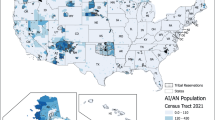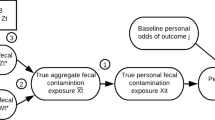Abstract
Epidemiologists often use a retrospective study design to examine for associations between an exposure and the occurrence of adverse health effects. Several of these studies used this approach to examine for an association between elevated levels of nitrate in drinking water and related health effects such as methemoglobinemia, cancer, neural tube effects, or spontaneous abortions. Often, data on exposures that occurred before these health outcomes were not available. Consequently, researchers use measurements of exposures at the time of the study to represent exposures that occurred before people developed these conditions. An opportunity to examine the stability of nitrate in water occurred during a survey of private water wells in nine Midwestern states. In this survey, water samples from 853 homes with drilled wells were collected in May 1994 and in September 1995 and nitrate-nitrogen (nitrate-N) was measured by the colorimetric cadmium reduction method. Nitrate-N levels from the same well over time were assessed by a mixed-effects analysis of variance. Analysis showed no significant difference in between the initial level and those measured 16 months later. Furthermore, analysis showed that most of the variance in the nitrate concentrations in well water was due to well-to-well variation (89%) rather than to residual error (12%). This observation showed that a single measurement of nitrate in water from drilled wells could represent longer periods of exposure.
This is a preview of subscription content, access via your institution
Access options
Subscribe to this journal
Receive 6 print issues and online access
$259.00 per year
only $43.17 per issue
Buy this article
- Purchase on Springer Link
- Instant access to full article PDF
Prices may be subject to local taxes which are calculated during checkout
Similar content being viewed by others
References
American Public Health Association. Cadmium Reduction Method. In: Greenberg AE, Clesceri LS, Eaton AD (ed.) Standard Methods for the Examination of Water and Wastewater. American Public Health Association: Washington, DC, 1992 Section 4-87-88.
Benes V., Pekny V., Skorepa J., and Vrba J. Impact of diffuse nitrate pollution sources on groundwater quality-some examples from Czechoslovakia. Environ Health Perspect 1989: 83: 5–24.
Centers for Disease Control and Prevention (CDC). Spontaneous abortions possibly related to ingestion of nitrate-contaminated well water - LaGrange County, Indiana, 1991–1994. MMWR 1994: 45 (26): 569–572.
Centers for Disease Control and Prevention (CDC). A Survey of the quality of water drawn from domestic wells in nine midwestern states. Centers for Disease Control and Prevention, Atlanta, GA, 1998.
Devine O.J., and Smith J.M. Estimating sample size for epidemiologic studies: the impact of ignoring exposure measurement uncertainty. Stat Med 1998: 17: 1375–1389.
Dorsch M.M., Scragg R.K.R., McMichael A.J., Baghurst P.A., and Dyer K.F. Congenital malformations and maternal drinking water supply in rural South Australia: a case control study. J Epidemiol 1984: 119: 473–485.
Eichholzer M., and Gutzwiller F. Dietary nitrates, nitrites, and N-nitroso compounds and cancer risk: a review of the epidemiologic evidence. Nutr Rev 1998: 56: 95–105.
Fan A.M., Willhite C.C., and Book S.A. Evaluation of the nitrate drinking water standard with reference to infant methemoglobinemia and potential reproductive toxicity. Regul Toxicol Pharmacol 1987: 7: 135–148.
Fan A.M., and Steinberg V.E. Health implications of nitrate and nitrite in drinking water: an update on methemoglobinemia occurrence and reproductive and developmental toxicity. Regul Toxicol Pharmacol 1996: 23: 35–43.
Hallberg G.R., Libra R.D., Ressmeyer G.G., Bettis E.A., and Hoyer B.E. Temporal changes in nitrates in groundwater in Northeastern Iowa. Iowa Geological Survey Open-File Report 1984, 81–84.
Johnson C.J., and Kross B.C. Continuing importance of nitrate contamination of groundwater and wells in rural areas. Am J Ind Med 1990: 18 (4): 449–456.
Kross B.C., Hallberg G.R., Bruner D.R., Cherryholmes K., and Johnson J.K. The nitrate concentration of private well water in Iowa. Am J Public Health 1993: 83 (2): 270–272.
Landon M.K., Delin G.N., Komor S.C., and Regan C.P. Relation of pathways and transit times of recharge water to nitrate concentration using stable isotopes. Ground Water 2000: 38: 381–395.
Maloney W.J., MacFarlane M.T., and Rimsza M.E. Methemoglobinemia in an infant. Arizona Med 1983: 40 (10): 700–702.
McDonald D.B., and Splinter R.C. Long-term trends in nitrate concentration in Iowa water supplies. J AWWA 1982: 74 (8): 437–440.
Montgomery E., Coyne M.S., and Thomas G.W. Denitrification can cause variable nitrate concentrations in shallow groundwater. Soil Sci 1997: 162: 148–156.
Mueller D.K., Hamilton P.A., Helsel D.R., Hitt K.J., and Ruddy B.C. Nutrients in ground water and surface water of the United States - an analysis of data through 1992, Water-Resources Investigations Report 95-4031. United States Geological Survey, Denver, 1995.
Mueller D.K., and Helsel D.R. Nutrients in the nation's waters - too much of a good thing?, US Geological Survey Circular 1136. United States Geological Survey, Denver, 1996.
SAS Institute Inc. SAS Technical Report P-229, SAS/STAT Software: Changes and enhancements, Release 6.0. SAS Institute Inc.: Cary, NC, USA, 1992 p 620.
Scragg R.R., Dorsch M.M., McMichael A.J., and Bayhurst P.A. Birth defects and household water supply. Epidemiologic studies in the Mount Zambia region of South Australia. Med J Australia 1982: 2: 577–579.
Swann P.F. The toxicology of nitrate, nitrite and N-nitroso compounds. J Sci Fd Agric 1975: 26: 1761–1770.
Townsend M.A., and Young D.P. Assessment of nitrate-nitrogen distribution in Kansas groundwater. Natural Resources Res 2000: 9: 125–134.
US EPA. Drinking Water Regulations and Health Advisories, EPA 822-R-94-001 Environmental Protection Agency, Washington, DC, 1994.
USGS. 2001. Nutrients in the nation's ground waters – too much of a good thing?, http://water.usgs.gov/nawqa/circ-1136/h4.html).
Author information
Authors and Affiliations
Corresponding author
Rights and permissions
About this article
Cite this article
Ruckart, P., Henderson, A., Black, M. et al. Are nitrate levels in groundwater stable over time?. J Expo Sci Environ Epidemiol 18, 129–133 (2008). https://doi.org/10.1038/sj.jes.7500561
Received:
Accepted:
Published:
Issue Date:
DOI: https://doi.org/10.1038/sj.jes.7500561
Keywords
This article is cited by
-
Impacts of climate change on groundwater quality in Coimbatore smart city areas of Tamil Nadu, India
Environmental Earth Sciences (2023)
-
Evaluation of Nitrate Effects on the incidence of gastrointestinal cancers in Isfahan province, Iran
Arabian Journal of Geosciences (2022)
-
Water quality monitoring records for estimating tap water arsenic and nitrate: a validation study
Environmental Health (2010)



